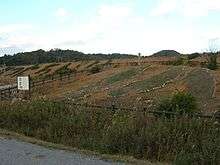Irago Tōdai-ji Tile Kiln ruins
The Irago Tōdai-ji Tile Kiln ruins (伊良湖東大寺瓦窯跡, Irago Tōdaiji gayō iseki) is an archaeological site containing the remnants of a number of Anagama kilns, from which the roof tiles for the Kamakura period reconstruction of the temple of Tōdai-ji in Nara were made. The site is located in what is now part of the city of Tahara, Aichi Prefecture in the Tōkai region of Japan. It was designated a National Historic Site of Japan in 1967.[1]
伊良湖東大寺瓦窯跡 | |
 Irago Tōdai-ji Tile Kiln ruins | |
 Irago Tōdai-ji Tile Kiln ruins  Irago Tōdai-ji Tile Kiln ruins (Japan) | |
| Location | Tahara, Aichi, Japan |
|---|---|
| Region | Tōkai region |
| Coordinates | 34°35′42″N 137°03′23″E |
| History | |
| Periods | Kamakura period |
| Site notes | |
| Ownership | National Historic Site |
| Public access | Yes |
Overview
In 1180 AD, during the Genpei War of the late Heian period, the great temple of Tōdai-ji was burned down by Heike forces. The temple was rebuilt by the Kamakura shogunate in 1195 AD. During the construction of an irrigation dam at the tip of Atsumi Peninsula in 1966, the remnants of a kiln were discovered. This lent evidence to local legend that the tiles for the temple of Tōdai-ji had been produced from clay in this area. Further investigation of shards found at the site, as well as earlier finds from the Edo period in this neighborhood, revealed a number of ink markings and inscriptions which were identical to markings on existing tiles preserved at Tōdai-ji. A more detailed archaeological excavation revealed that the site consisted of three noborigama-style kilns and one flat kiln. The kilns were from 11.5 to 12.3 meters in length, and had a maximum width of 2.5 meters.
Excavated items are now displayed at the Folklore Museum of Tahara City.
References
- "伊良湖東大寺瓦窯跡" [Irago Todaiji kawara-kama ato] (in Japanese). Agency for Cultural Affairs.